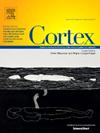Effective neural connectivity deficits during speech auditory feedback processing in post-stroke aphasia: An fMRI study
IF 3.2
2区 心理学
Q1 BEHAVIORAL SCIENCES
引用次数: 0
Abstract
Post-stroke aphasia often results in significant impairments in speech production and auditory processing, necessitating a deeper understanding of the underlying neural connectivity within sensorimotor networks. In this study, we investigated neural connectivity within sensorimotor networks in individuals with post-stroke aphasia (n = 16) compared to neurotypical controls (n = 16). Functional magnetic resonance imaging (fMRI) data were acquired during speaking and listening tasks, accompanied by normal or randomly pitch-shifted (±100 cents) altered auditory feedback across trials. Dynamic causal modeling and parametric empirical bayes methods were used to analyze effective connectivity. The analysis revealed significant alterations in intrinsic and extrinsic connectivity patterns, indicating primarily decreased connectivity in the aphasia group during listening and mixed modulation during speaking. Notably, increased self-inhibition was observed in the left precentral gyrus (PrCG), suggesting impaired feedforward mechanisms essential for speech production. Additionally, functional reorganization was evident, with increased connectivity from the right PrCG to the right superior temporal gyrus, reflecting potentially compensatory processes following left-hemisphere damage. These findings contribute to the growing evidence of an impaired and redistributed bilateral speech networks following left-hemisphere stroke. Our data emphasizes the importance of examining the receptive and productive aspects of speech impairment within sensorimotor networks for aphasia treatment.
脑卒中后失语症言语听觉反馈加工过程中有效的神经连通性缺陷:一项功能磁共振成像研究
中风后失语症通常会导致言语产生和听觉处理的严重损伤,因此需要对感觉运动网络中潜在的神经连接进行更深入的了解。在这项研究中,我们研究了脑卒中后失语症患者(n = 16)与正常对照组(n = 16)的感觉运动网络内的神经连通性。功能磁共振成像(fMRI)数据是在说和听任务中获得的,伴随着正常或随机音高偏移(±100美分)改变的听觉反馈。采用动态因果模型和参数经验贝叶斯方法分析有效连通性。分析显示,内部和外部连接模式发生了显著变化,表明失语症组在听时连接减少,在说时混合调制。值得注意的是,在左中央前回(PrCG)中观察到自我抑制增强,这表明言语产生所必需的前馈机制受损。此外,功能重组是明显的,从右PrCG到右颞上回的连通性增加,反映了左半球损伤后潜在的代偿过程。这些发现为左半球中风后双侧语言网络受损和重新分配提供了越来越多的证据。我们的数据强调了在失语症治疗中检查感觉运动网络中语言障碍的接受性和生产性方面的重要性。
本文章由计算机程序翻译,如有差异,请以英文原文为准。
求助全文
约1分钟内获得全文
求助全文
来源期刊

Cortex
医学-行为科学
CiteScore
7.00
自引率
5.60%
发文量
250
审稿时长
74 days
期刊介绍:
CORTEX is an international journal devoted to the study of cognition and of the relationship between the nervous system and mental processes, particularly as these are reflected in the behaviour of patients with acquired brain lesions, normal volunteers, children with typical and atypical development, and in the activation of brain regions and systems as recorded by functional neuroimaging techniques. It was founded in 1964 by Ennio De Renzi.
 求助内容:
求助内容: 应助结果提醒方式:
应助结果提醒方式:


